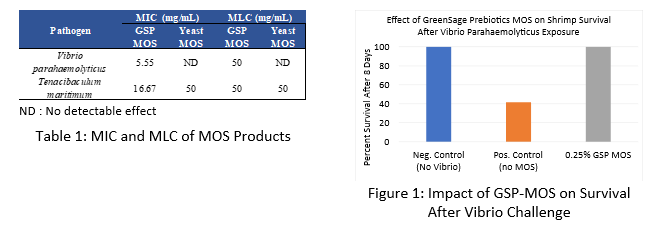SOLUBLE MANNO-OLIGOSACCHARIDES FOR PATHOGEN CONTROL IN AQUACULTURE
Infections caused by Vibrio spp. and Tenacibaculum spp. have led to billions of dollars in losses in the aquaculture industry, yet there are few options to prevent or manage these infections in shrimp, salmon, and other aquaculture species.
Manno-oligosaccharides (MOS) are widely recognized for their ability to control pathogens such as Salmonella spp. and E. coli in the poultry and livestock industries, but are little used in aquaculture. GreenSage Prebiotics (GSP) has developed a high purity, soluble MOS targeted at key pathogens impacting aquaculture, animal, and human health.
GSP has conducted in vitro and in vivo trials to evaluate its novel MOS product (GSP_MOS).
In vitro trials to determine the minimum inhibitory concentration (MIC) and minimum lethal concentration (MLC) of GSP-MOS versus Vibrio parahaemolyticus and Tenacibaculum maritimum demonstrated the effectiveness of GSP-MOS and the superiority of GSP-MOS versus low purity, insoluble yeast-based MOS products (Table 1).
Additional in vitro studies have demonstrated efficacy of GSP-MOS versus Salmonella enteritidis and E. coli, and have shown enhanced growth of beneficial microbes, including probiotics such as Lactobacillus spp., which can collectively support the digestive and immune systems.
An in vivo Vibrio parahaemolyticus challenge trial was completed in shrimp, following two weeks of consumption of feed containing GSP-MOS. Shrimp consuming 0.25 wt% GSP-MOS had 100% survival following a Vibrio challenge, compared to 42% survival in shrimp that did not receive MOS (Figure 1).
This presentation will discuss the benefits of high purity, soluble MOS as a feed additive for control of pathogens, and the corresponding impacts on aquaculture and animal health.
